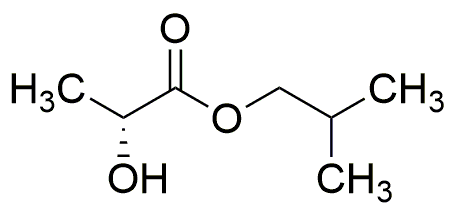Isobutyl (R)-(+)-lactate is widely utilized in research focused on:
- Flavoring and Fragrance Industry: This compound is used as a flavoring agent in food products and beverages, providing a pleasant fruity aroma that enhances consumer appeal.
- Cosmetic Formulations: Its emollient properties make it a valuable ingredient in skincare products, improving texture and moisture retention, which is essential for creams and lotions.
- Pharmaceutical Applications: It serves as a solvent and excipient in drug formulations, aiding in the delivery of active ingredients while ensuring stability and efficacy.
- Biodegradable Plastics: The compound is explored in the development of eco-friendly plastics, contributing to sustainable materials that reduce environmental impact.
- Research and Development: In laboratories, it is used as a reagent in organic synthesis, facilitating various chemical reactions due to its unique structural properties.
General Information
Properties
Safety and Regulations
Applications
Isobutyl (R)-(+)-lactate is widely utilized in research focused on:
- Flavoring and Fragrance Industry: This compound is used as a flavoring agent in food products and beverages, providing a pleasant fruity aroma that enhances consumer appeal.
- Cosmetic Formulations: Its emollient properties make it a valuable ingredient in skincare products, improving texture and moisture retention, which is essential for creams and lotions.
- Pharmaceutical Applications: It serves as a solvent and excipient in drug formulations, aiding in the delivery of active ingredients while ensuring stability and efficacy.
- Biodegradable Plastics: The compound is explored in the development of eco-friendly plastics, contributing to sustainable materials that reduce environmental impact.
- Research and Development: In laboratories, it is used as a reagent in organic synthesis, facilitating various chemical reactions due to its unique structural properties.
Documents
Safety Data Sheets (SDS)
The SDS provides comprehensive safety information on handling, storage, and disposal of the product.
Product Specification (PS)
The PS provides a comprehensive breakdown of the product’s properties, including chemical composition, physical state, purity, and storage requirements. It also details acceptable quality ranges and the product's intended applications.
Certificates of Analysis (COA)
Search for Certificates of Analysis (COA) by entering the products Lot Number. Lot and Batch Numbers can be found on a product’s label following the words ‘Lot’ or ‘Batch’.
*Catalog Number
*Lot Number
Certificates Of Origin (COO)
This COO confirms the country where the product was manufactured, and also details the materials and components used in it and whether it is derived from natural, synthetic, or other specific sources. This certificate may be required for customs, trade, and regulatory compliance.
*Catalog Number
*Lot Number
Safety Data Sheets (SDS)
The SDS provides comprehensive safety information on handling, storage, and disposal of the product.
DownloadProduct Specification (PS)
The PS provides a comprehensive breakdown of the product’s properties, including chemical composition, physical state, purity, and storage requirements. It also details acceptable quality ranges and the product's intended applications.
DownloadCertificates of Analysis (COA)
Search for Certificates of Analysis (COA) by entering the products Lot Number. Lot and Batch Numbers can be found on a product’s label following the words ‘Lot’ or ‘Batch’.
*Catalog Number
*Lot Number
Certificates Of Origin (COO)
This COO confirms the country where the product was manufactured, and also details the materials and components used in it and whether it is derived from natural, synthetic, or other specific sources. This certificate may be required for customs, trade, and regulatory compliance.


